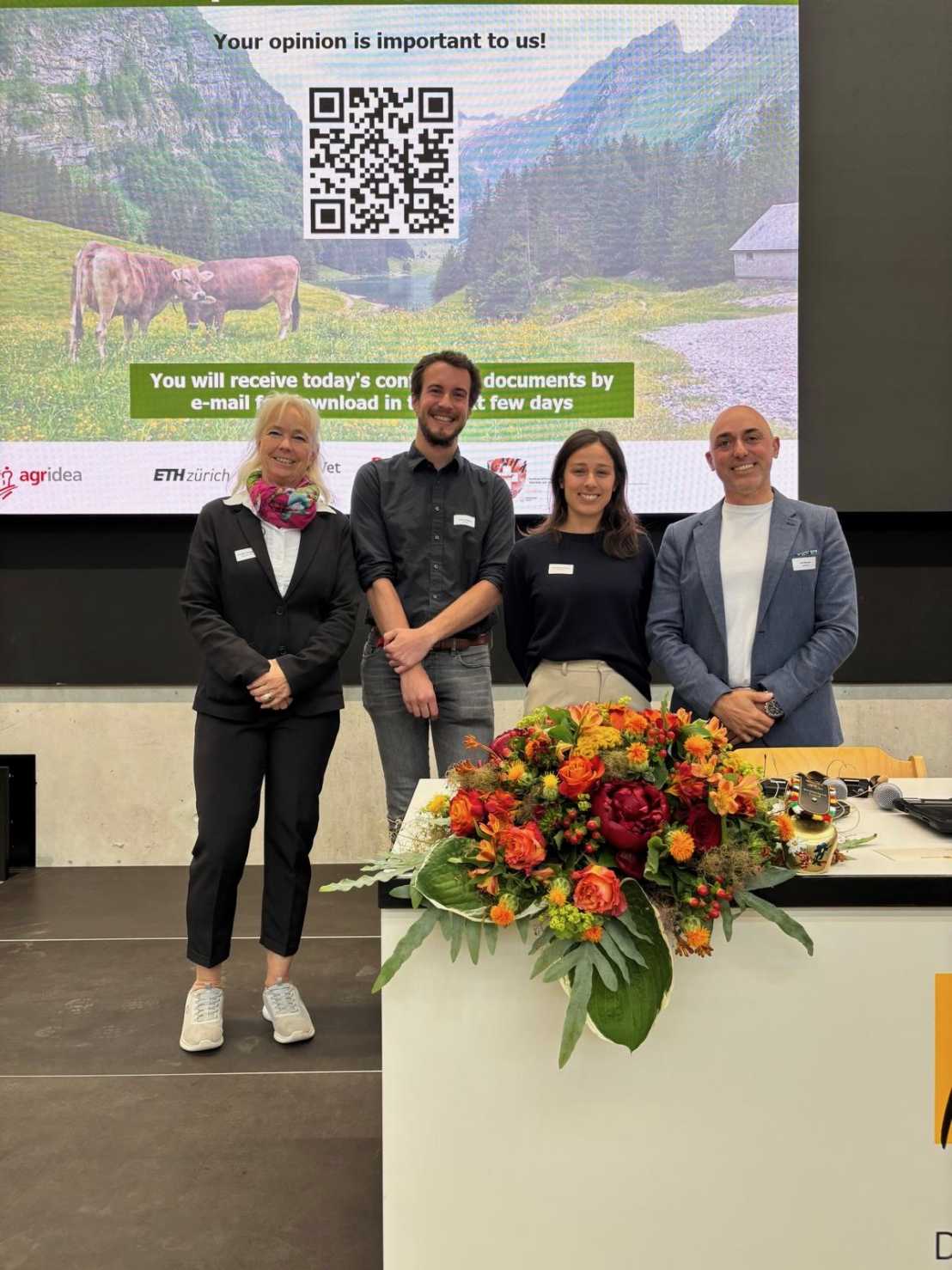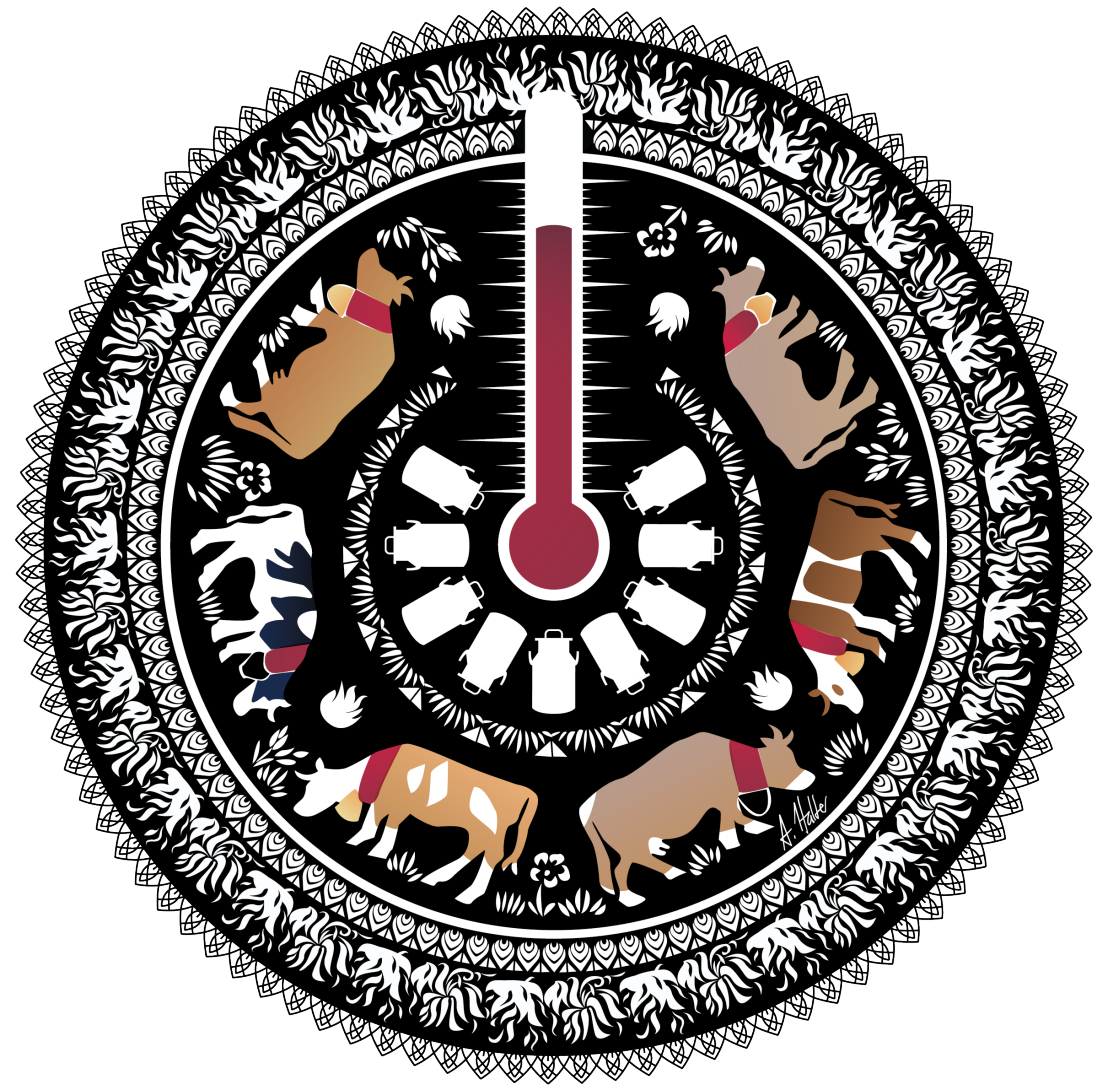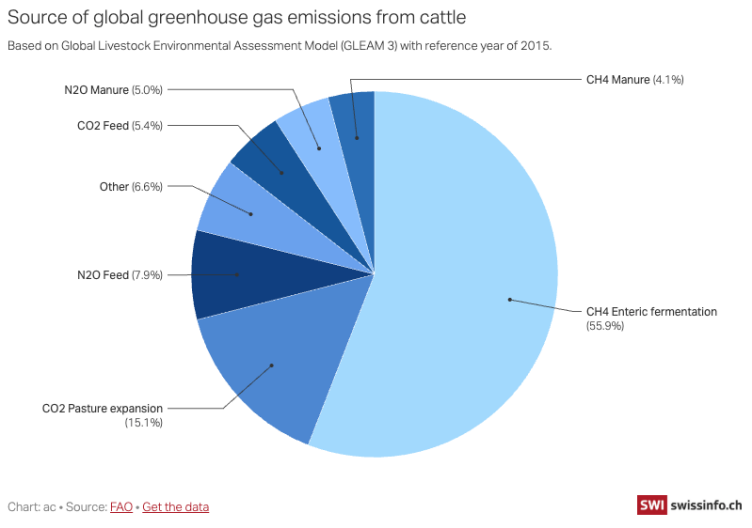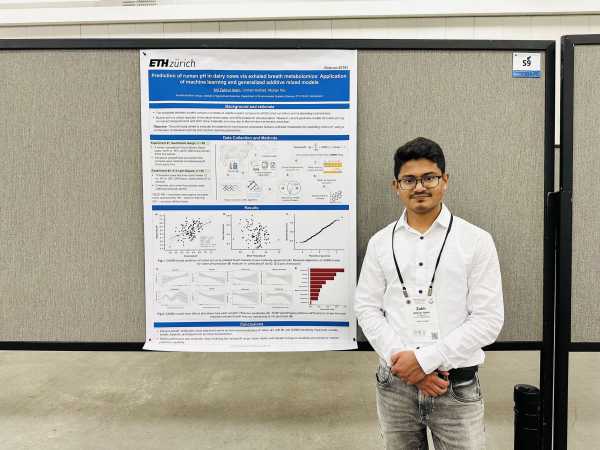The Feed
Fresh insights, smart solutions, and the science behind them
The Animal Nutrition Group at ETH Zurich actively participated in the American Dairy Science Association (ADSA) external page 2025 Annual Meeting in Louisville, Kentucky, engaging with researchers and industry professionals from around the world.
Our team presented cutting-edge research on ruminant nutrition, methane and nitrogen excretion mitigation, and exhalomics, including exciting developments in multi-omics integration for dairy cows. The conference provided a fantastic platform to reconnect with colleagues, exchange ideas, and explore new collaborations.
Special thanks to our mentors and collaborators—Mutian Niu, Susanna Räisänen, Usman Arshad, Renato Zenobi, Stamatis Giannoukos, Fabian Wahl, Emma Slack, Jiayi L., Marie Schölmerich, Hanna Zehnle, and Bledina Dede—for their invaluable support.
And of course, it was a pleasure to catch up with Jorge Barrientos Blanco—science, friendship, and a bit of Kentucky bourbon made for a memorable ADSA experience!
Here's to more innovation and collaboration in dairy science!
List of presentations Animal Nutrition Group at ADSA 2025:
- pwr4exp: An R package for robust statistical power analysis – Kai Wang (oral)
- Effects of whey and 3-nitroxypropanol (3-NOP) supplementation on lactational performance and enteric methane in dairy cows - Kai Wang (oral)
- Metagenomic insights into rumen microbial responses to high- or low-starch diets in Original Brown Swiss cows – Md Zakirul Islam (oral)
- Sniffer Position in an Automated Milking System Affects the Variability, Repeatability and Ranking of Enteric Methane Emission Measurements of Dairy Cows – Xiaoqi Ma (oral)
- Identification of anti-methanogenic compounds using in silico docking and in vitro ruminal fermentation techniques – Senlin Zhu (oral)
- Can we assess fermentative and metabolic heat production loss using exhalomics in dairy cows? – Mario Barrientos Blanco (poster)
- Characterizing dairy cow metabolic profile through exhaled breath condensate analysis – Mario Barrientos Blanco (poster)
- Meta-analysis to determine the effects of supplementation of niacin during the transition or lactation period on performance in dairy cows – Usman Arshad (poster)
- Prediction of rumen pH in dairy cows via exhaled breath metabolomics: Application of machine learning and generalized additive mixed models - Md Zakirul Islam (poster)
- Effects of combining nitrate and tannins for methane mitigation in dairy cows – Rong Peng (poster)
- How does extra rumen-protected protein affect the influence of nitrate and tannin supplementation on nitrogen utilization and plasma metabolites? – Rong Peng (poster)
01.07.2025
ETH Animal Nutrition Group Showcases Innovation in Animal Science and AI

Recently, the Animal Nutrition Group at ETH Zurich has played a central role in two major conferences that highlighted cutting-edge research and international collaboration in animal science: the Swiss Animal Nutrition Conference 2025 and the 1st EAAP Conference on Artificial Intelligence in Animal Science (AI4AS).
The Swiss Animal Nutrition Conference 2025 brought together leading experts from across Europe, including Jan Dijkstra (Wageningen University), Marketta Rinne (Natural Resources Institute Finland), and Knud Erik Bach Knudsen (Aarhus University), alongside Swiss researchers Florian Leiber (FiBL) and Giuseppe Bee (Agroscope). Topics ranged from sustainable dairy systems to fiber in non-ruminant diets, with over 30 poster presentations from institutions such as ETH Zurich, University of Zurich, and international contributors from the USA, Poland, and Bangladesh.
Poster prizes were awarded to:
Julie Botzas-Coluni (Agroscope) – “Sheep Preferences for Five Fodder Tree Species” (Public Vote)
Jonas Hendricks (Agroscope/ETH) – “Subclinical Ketosis Challenge in Transition Dairy Cows” (Scientific Committee Award)
Meanwhile, the AI4AS Conference, co-organized by European Federation of Animal Science (EAAP) in collaboration with ETH Zurich, Agroscope, and the Swiss Association for Animal Sciences (SVT), marked a milestone in integrating artificial intelligence into animal science. With over 200 participants, the event featured cutting-edge research on AI applications in animal health, behavior, and environmental monitoring.
Members of the D-USYS Insititute of Agricultural Sciences were part of the organising and scientific commitees. Professors Hubert Pausch and Mutian Niu chaired sessions during the conference. ETH was represented in the following presentations:
- AI for Healthcare: a multimodal perspective, T. Sutter, D-INFK Professorship for Medical Data Science (Keynote)
- Virtual Screening for Methane Emission Mitigation in Ruminants, S. Zhu, G. Foggi, R. Peng, S. Riniker, M. Niu, ETH D-USYS IAS Animal Nutrition (Poster)
- Automated detection of perturbations in pigs’ feed intake and feeding behavior as a resilience indicator W. Gorssen, C. Winters, H. Pausch, ETH D-USYS IAS Animal Genomics (Oral)
- High-density 3D pose estimation for pigs: enhancing anatomical precision for social behavior analysis C. Winters, S. E. Ulbrich, S. Goumon, ETH D-USYS IAS Animal Physiology (Oral)
- AI-Driven Cloud-Edge Framework for Automated Feral Pigeon Monitoring in Urban Environments C. Guo, L. Lyu, Z. Guo, Z. He, K. Liu (Oral - C. Guo is currently an academic guest at ETH, D-USYS IAS Animal Nutrition)
Following the success of AI4AS, EAAP announced the formation of a dedicated AI working group and plans for a second edition of the conference in 2026.
These events reflect the ETH Animal Nutrition Group’s dynamic role in shaping the future of animal science—where tradition meets technology, and sustainability meets smart systems.
01.07.2025, E.Broxham/Copilot
Celebrating Our Graduating Students – Summer 2025

As another academic year comes to a close, we are proud to celebrate the accomplishments of our graduating students who have completed their Master's theses within our research group. Their dedication, curiosity, and hard work have contributed meaningfully to the field, and we are excited to see where their journeys take them next.
A special congratulations goes to Alana Schudel, who has been awarded the prestigious Wilhelm Schaumann Prize for her outstanding Master's thesis titled:
"Lactational performance and nitrogen efficiency of dairy cows on low protein diets with supplemental energy and rumen-protected histidine."
We also extend our warmest congratulations to Martin Huser and Arno Schneuwly for successfully completing their theses.
To all our graduates: thank you for your contributions, and we wish you continued success in your future endeavors!
Link to news item about the Masters graduation ceremony
More information on Arno's research on Heat Stress in Dairy Cows below.
Heat Stress in Dairy Cows: New Insights from Swiss Data

As climate change intensifies, understanding how rising temperatures affect livestock is becoming increasingly important. A external page recent study sheds light on how heat stress impacts yields of milk and energy-corrected milk (ECM) in dairy cows across Switzerland, using an unprecedented dataset of over 130 million records and involving 4.2 million cows from three national breeding associations. Generalized Additive Mixed Models were employed separately for six breeds to capture the non-linear effects of temperature-humidity index (THI), while accounting for non-linear effects of lactation stage (days in milk), fixed effects of parity (primiparous vs. multiparous) and year, and random effects of cow, farm, and zip code nested within test-day records.
Results indicated that the thermoneutral zone for dairy cows in Switzerland lies at a lower THI range than typically observed in barn-based production systems and temperate regions of the world, where heat stress is generally reported at THI thresholds exceeding 68. Across breeds, milk and ECM yields peaked at mean THI values from 46 to 58, with the upper end of this range corresponding to peak milk yield in Jerseys. Cows appeared susceptible to heat stress beginning as early as March, with effects extending into late autumn. These findings highlight the need for region-specific management strategies and the incorporation of heat resilience traits in future breeding programs. The study also suggests that heat tolerance may have declined over time, with cows in the post-2010 period showing lower THI thresholds, possibly a side effect of breeding practices focused on productivity.
Despite its scale and sophistication, the study acknowledges several limitations. Notably, it does not yet account for differences between high- and low-producing cows, a factor known to influence heat sensitivity. The use of subsampled single-breed models, while necessary due to computational constraints, might limit the ability to statistically compare breeds. Additionally, the models assume independent data points, which may not fully reflect the spatial and temporal clustering inherent in farm-based data. The treatment of farm location as a random effect, rather than a fixed one, also remains a topic for further exploration.
Looking ahead, the researchers outline seven key directions for future work. These include refining model selection and subsampling strategies, incorporating production levels, and exploring fixed versus random effects for farm location. They also propose controlling for additional weather variables like solar radiation and precipitation, analyzing other milk quality indicators such as lactose and somatic cell count, and modeling interactions between THI and days in milk. Finally, the study introduces new computational tools to extend GAMM capabilities, which, with further validation, could support broader applications in agricultural research and practice.
Links to the full external page report and external page codes
15.05.2025 Written with AI support (Microsoft Copilot)
Methane emissions from livestock are a major contributor to greenhouse gases, making sustainable animal nutrition a crucial area of research

I am Enrico Colella, an Italian exchange student from Wageningen University, and during my exchange semester at ETH Zurich, I had the opportunity to contribute to this field through the “Training Course in Group: Large,” working alongside Professor Mutian Niu and PhD student Kai Wang in the Animal Nutrition Research Group.
The project focused on exploring dietary strategies to reduce methane emissions in dairy cows, specifically investigating the potential synergy between 3-NOP, a commercially available methane inhibitor known as Bovaer, and whey powder. While 3-NOP had already been proven effective in lowering methane production, our study aimed to assess whether combining it with whey powder enhanced its effect through interactions with rumen microbiota, particularly lactic acid bacteria.
Research at ETH Zurich
The experiment took place at the research facility AgroVet-Strickhof, a collaboration between ETH Zurich, University of Zurich and Strickhof.
Using a 2x2 factorial design, 24 cows were assigned to four different treatment groups: placebo, Bovaer, placebo + whey, and Bovaer + whey. Over a 12-week period, various samples were collected and analyzed, including rumen fluid for microbiome studies, fecal samples to assess digestibility, and milk samples to evaluate production efficiency and methane intensity.
My role in the research involved hands-on work essential to the study’s execution. I collected various samples such as milk, feed, and rumen fluid, along with performing practical tasks such as feeding and milking cows. The collection of samples was followed by physical processes including grinding, drying, and weighing. Afterwards, data was analyzed. I also managed GreenFed functions (a turn-key system designed to measure gas fluxes of methane (CH4), carbon dioxide (CO2), and optionally, oxygen (O2), and hydrogen (H2) from individual animals), transcribed experimental data, assisted in laboratory procedures, and oversaw fecal schedule processes.
Through this, I gained direct experience in livestock research methodologies.
Beyond the technical work, this experience provided a valuable perspective on the inner workings of academic research. I saw firsthand how interdisciplinary collaboration, experimental design, and data collection functioned in practice.
Although my participation concluded at the end of the data collection phase, the study continued under Kai Wang’s supervision, with ongoing analysis to determine the effectiveness of the whey powder and Bovaer combination.
Moreover, by being fully immersed in the Animal Nutrition Group and participating in weekly group meetings, I gained a deeper understanding of how research was conducted, who was involved, and how supervision worked. I learned about the different hierarchies in a scientific group, the role of the professor, and how they managed experiments, finances, and a team composed of PhD students and postdoctoral scientists.
This training course provided a unique and enriching opportunity to delve deeper into animal nutrition research while contributing to a broader discussion on agricultural sustainability. My time at ETH Zurich reinforced the importance of innovative solutions in addressing environmental challenges in livestock farming. By sharing this experience, I hope to inspire other students to engage in sustainability-focused scientific research.
21.03.2025
Are Food Firms’ Efforts to Reduce Cow Methane Emissions Effective? An Interview with Mutian Niu

Methane emissions from cattle, a major contributor to climate change, have drawn increasing attention from multinational food companies. In a recent SWI swissinfo.ch article, Mutian Niu, professor of animal nutrition at ETH Zurich, shares expert insights on the role of feed additives in tackling this issue.
Mutian Niu: The Science Behind Feed Additives
Niu explains that methane from cows is primarily produced by microbes in their digestive system, particularly in the rumen. Scientists have been exploring ways to modify this microbial activity through feed additives, which can either inhibit key enzymes in methane production or alter gut conditions to suppress methanogenesis.
One of the most researched additives is 3-NOP (3-nitrooxypropanol), which has demonstrated a methane reduction potential of up to 30% in controlled trials. Other natural solutions, such as plant extracts and seaweed-based supplements, are also being tested. However, Niu emphasizes that the long-term effectiveness of these solutions depends on factors like diet composition, animal health, and farm management practices.
Beyond methane reduction, Niu highlights that some feed additives could increase milk production efficiency by redirecting energy that would otherwise be lost as methane. This dual benefit has made them an attractive option for both researchers and the dairy industry. However, Niu cautions that real-world results can vary, and more large-scale studies are needed to assess their impact across different farming systems.
Industry Efforts and Challenges
Food giants are promoting feed-based methane reduction as part of their sustainability strategies. Swiss farmers, for instance, have tested plant-based additives, achieving a 10-20% reduction in methane emissions. However, experts note that practical experience with these additives remains limited, and their effectiveness outside controlled studies is still uncertain.
The Road Ahead
While companies push forward with methane-reducing solutions, experts like Niu stress the need for long-term trials and policy support to ensure these methods are viable, cost-effective, and widely adopted.
👉 Read the full article on SWI swissinfo.ch to explore the full scope of the discussion. (external page Read More)
05.03.2025 (article created with the support of AI)


